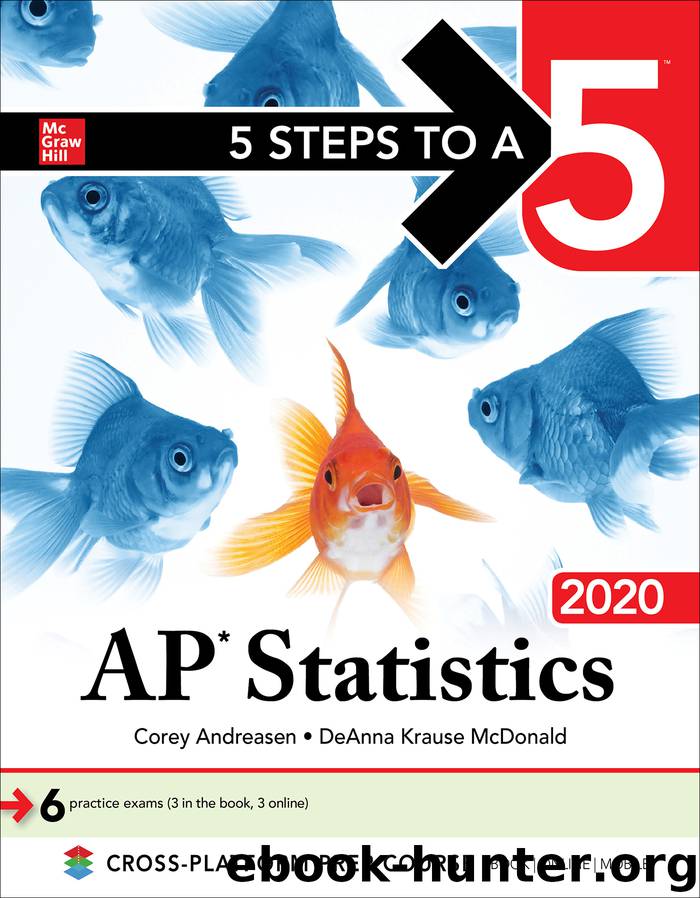5 Steps to a 5: AP Statistics 2020 by Corey Andreasen

Author:Corey Andreasen
Language: eng
Format: epub
Publisher: McGraw-Hill Education
Published: 2019-08-02T16:00:00+00:00
Geometric Distributions
In the Binomial Distributions section of this chapter, we defined a binomial setting as an experiment in which the following conditions are present:
• The experiment consists of a fixed number, n, of identical trials.
• There are only two possible outcomes: success (S) or failure (F).
• The probability of success, p, is the same for each trial.
• The trials are independent (that is, knowledge of the outcomes of earlier trials does not affect the probability of success of the next trial).
• Our interest is in a binomial random variable X, which is the count of successes in n trials. The probability distribution of X is the binomial distribution.
There are times we are interested not in the count of successes out of n fixed trials, but in the probability that the first success occurs on a given trial, or in the average number of trials until the first success. A geometric setting is defined as follows.
• There are only two possible outcomes: success (S) or failure (F).
• The probability of success, p, is the same for each trial.
• The trials are independent (that is, knowledge of the outcomes of earlier trials does not affect the probability of success of the next trial).
• Our interest is in a geometric random variable X, which is the number of trials necessary to obtain the first success.
Note that if X is a binomial, then X can take on the values 0, 1, 2, …, n. If X is geometric, then it takes on the values 1, 2, 3, …. There can be zero successes in a binomial, but the earliest a first success can come in a geometric setting is on the first trial.
If X is geometric, the probability that the first success occurs on the nth trial is given by P(X = n) = p(1 − p)n−1. The value of P(X = n) in a geometric setting can be found on the TI-83/84 calculator, in the DISTR menu, as geometpdf(p,n) (note that the order of p and n are, for reasons known only to the good folks at TI, reversed from the binomial). Given the relative simplicity of the formula for P(X = n) for a geometric setting, it’s probably just as easy to calculate the expression directly. There is also a geometcdf function that behaves analogously to the binomcdf function, but is not much needed in this course.
example: Remember Maria, the basketball player whose free-throw shooting percentage was 0.65? What is the probability that the first free throw she manages to hit is on her fourth attempt?
solution: P(X = 4) = (0.65) (1 − 0.65)4–1 = (0.65) (0.35)3 = 0.028. This can be done on the TI-83/84 as follows: geometpdf(p,n) = geometpdf(0.65,4) = 0.028.
example: In a standard deck of 52 cards, there are 12 face cards. So the probability of drawing a face card from a full deck is 12/52 = 0.231.
(a) If you draw cards with replacement (that is, you replace the card in the deck before drawing the next card), what
Download
This site does not store any files on its server. We only index and link to content provided by other sites. Please contact the content providers to delete copyright contents if any and email us, we'll remove relevant links or contents immediately.
| Biomathematics | Differential Equations |
| Game Theory | Graph Theory |
| Linear Programming | Probability & Statistics |
| Statistics | Stochastic Modeling |
| Vector Analysis |
Modelling of Convective Heat and Mass Transfer in Rotating Flows by Igor V. Shevchuk(6391)
Weapons of Math Destruction by Cathy O'Neil(6139)
Factfulness: Ten Reasons We're Wrong About the World – and Why Things Are Better Than You Think by Hans Rosling(4691)
Descartes' Error by Antonio Damasio(3229)
A Mind For Numbers: How to Excel at Math and Science (Even If You Flunked Algebra) by Barbara Oakley(3217)
Factfulness_Ten Reasons We're Wrong About the World_and Why Things Are Better Than You Think by Hans Rosling(3197)
TCP IP by Todd Lammle(3131)
Fooled by Randomness: The Hidden Role of Chance in Life and in the Markets by Nassim Nicholas Taleb(3043)
Applied Predictive Modeling by Max Kuhn & Kjell Johnson(3018)
The Tyranny of Metrics by Jerry Z. Muller(3000)
The Book of Numbers by Peter Bentley(2907)
The Great Unknown by Marcus du Sautoy(2645)
Once Upon an Algorithm by Martin Erwig(2598)
Easy Algebra Step-by-Step by Sandra Luna McCune(2577)
Lady Luck by Kristen Ashley(2529)
Practical Guide To Principal Component Methods in R (Multivariate Analysis Book 2) by Alboukadel Kassambara(2497)
Police Exams Prep 2018-2019 by Kaplan Test Prep(2482)
All Things Reconsidered by Bill Thompson III(2355)
Linear Time-Invariant Systems, Behaviors and Modules by Ulrich Oberst & Martin Scheicher & Ingrid Scheicher(2331)
